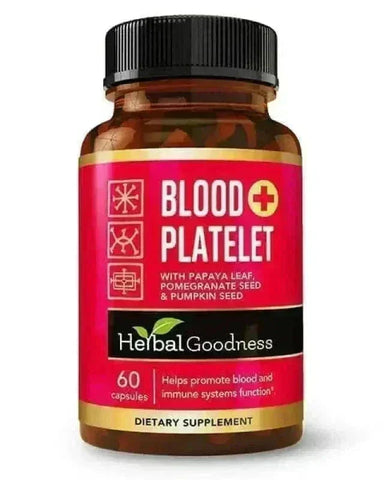Understanding Blood Platelets: The Silent Protectors in Your Blood
When you think of blood, red and white cells often come to mind. But there’s another vital component quietly working behind the scenes, blood platelets. These small, disc-shaped fragments are essential for blood clotting and healing. They prevent excessive bleeding and play a vital role in maintaining vascular integrity. In this blog, we’ll break down everything you need to know about blood platelets, from what they are, to how platelet count and mean platelet volume (MPV) affect your health, and the natural ways to support balanced platelet levels.
What Are Blood Platelets?
Blood platelets, or thrombocytes, are small cell fragments circulating in the blood. Unlike red or white blood cells, platelets don’t have a nucleus. Instead, they are fragments of larger cells called megakaryocytes, formed in the bone marrow.
Their primary function is hemostasis, stopping bleeding by clumping and forming plugs in blood vessel injuries. When an injury occurs, platelets rush to the site, stick together, and release chemical signals to form a temporary barrier, preventing blood loss.
Understanding Platelet Count
Your platelet count measures the number of platelets in a microliter of blood. A typical blood platelet count ranges from 150,000 to 450,000 platelets per microliter.
- Low platelet count (Thrombocytopenia): When platelets fall below 150,000.
- High platelet count (Thrombocytosis): When they exceed 450,000.
While fluctuations can occur, significant deviations might require medical attention or lifestyle changes.
Mean Platelet Volume (MPV): What It Reveals
Mean Platelet Volume (MPV) indicates the average size of platelets in your blood. It’s a key parameter in understanding platelet activity.
-
High MPV suggests newer, larger, and more active platelets—often produced in response to low platelet count.
-
Low MPV might indicate older or less active platelets.
Monitoring MPV helps doctors evaluate platelet production and bone marrow function.
Blood Plasma vs Platelets: What’s the Difference?
It’s easy to confuse blood plasma and platelets, but they serve distinct roles:
| Component | Description | Function |
|---|---|---|
| Plasma | The liquid portion of blood (about 55%) | Transports nutrients, hormones, and waste |
| Platelets | Tiny cell fragments suspended in plasma | Help form clots and repair tissue |
Both are crucial, plasma acts as the medium, while platelets are the responders that heal wounds.
Platelet-Rich Plasma (PRP): A Modern Innovation
Platelet-Rich Plasma (PRP) therapy uses concentrated platelets from your own blood to promote tissue recovery. Though widely used in modern remedy for cosmetic and sports treatments, it’s rooted in the body’s natural healing ability.
The concept highlights the power of platelets and their role in cell regeneration and repair.
Low Blood Platelets: Causes and Signs
A low blood platelet count (thrombocytopenia) may result from:
- Nutrient deficiencies (like vitamin B12 or folate)
- Certain medications or medical treatments
- Viral infections
- Bone marrow issues
Common signs may include easy bruising, nosebleeds, or prolonged bleeding from cuts. However, not all cases are severe, some are temporary and reversible through nutrition and lifestyle adjustments.
Thrombocytosis and High Platelet Count
Conversely, thrombocytosis occurs when platelet count is abnormally high. This may be reactive (due to inflammation or infection) or essential (resulting from bone marrow overproduction).
While platelets help prevent bleeding, excessive numbers can sometimes contribute to unwanted clot formation. That’s why balance, not just abundance, is key.
Which Foods Support Platelet Health?
If you’re wondering which food increases platelets in blood, the answer lies in a nutrient-rich, balanced diet. Certain foods help maintain normal platelet levels naturally:
- Leafy greens like spinach and kale (rich in vitamin K for clotting)
- Citrus fruits for vitamin C, supporting blood vessel health
- Papaya leaf extract, often used traditionally to support healthy platelet production
- Pumpkin, carrots, and beets for beta-carotene and antioxidants
- Iron-rich foods such as beans and lentils for red blood cell and platelet formation
While no food “cures” platelet issues, these natural sources help sustain optimal blood health.
What Is the Function of Blood Platelets?
Platelets perform several essential roles in the body:
- Clot Formation: Supports damaged vessel walls to stop bleeding.
- Wound Healing: Platelets supports growth factors that stimulate tissue repair.
- Immune Support: They interact with white blood cells to fight inflammation.
- Maintaining Vascular Integrity: Supports blood vessels to be stable and intact.
These functions make platelets one of the most vital, though often overlooked, components of your circulatory system.
Natural Support for Platelet Health
For individuals looking to maintain or support healthy platelet levels naturally, lifestyle habits matter:
- Eat a nutrient-dense, plant-rich diet.
- Stay hydrated to keep blood flow optimal.
- Avoid excessive alcohol and processed food.
- Get enough rest, platelet production happens in the bone marrow, which thrives when the body is well-rested.
The Role of Supplements like Platelet Plus
While food should always be your foundation, some people consider nutritional supplements to support their daily wellness routine. Herbal Goodness offers Blood Platelet Plus – Capsules (60/600mg), formulated with plant-based ingredients traditionally known to support healthy blood function and vitality.
This product aligns with Herbal Goodness’ commitment to purity, sustainability, and premium sourcing, offering nature-inspired support for your wellness journey.
FAQ Section
1. What are blood platelets and why are they important?
Blood platelets are small cell fragments that help stop bleeding and promote healing after injuries.
2. What is the normal blood platelet count?
A healthy blood platelet count ranges from 150,000 to 450,000 platelets per microliter of blood.
3. What does mean platelet volume (MPV) mean?
MPV measures the average size of platelets, helping doctors assess their activity and production rate.
4. What causes low blood platelet count?
Common causes include nutrient deficiencies, infections, or certain medications.
5. Which foods help increase platelets in blood?
Leafy greens, citrus fruits, papaya leaf extract, and iron-rich foods support healthy platelet formation.
6. What’s the difference between blood plasma and platelets?
Plasma is the fluid component that transports nutrients, while platelets are fragments that aid clotting.
7. How do supplements like Platelet Plus support blood health?
They provide plant-based nutrition that complements a balanced diet to help maintain wellness and vitality.
Support Your Blood Health Naturally
Experience the natural benefits of Blood Platelet Plus – Capsule 60/600mg, responsibly sourced and crafted with care.
This premium herbal supplement is designed to support your wellness routine and promote balance from within.
Shop Blood Platelet Plus – Capsule 60/600mg at HerbalGoodnessco.com
National Library of Remedy (NIH): “Understanding Platelet Biology and Function.”













